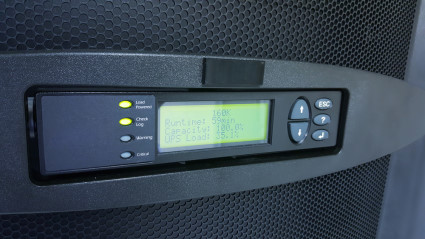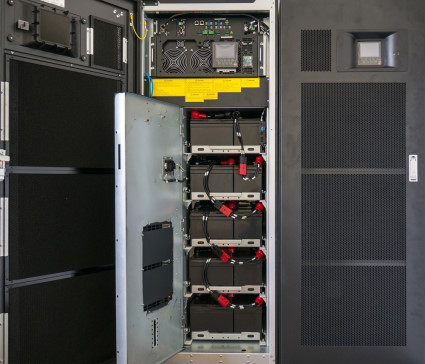Selecting and sizing an uninterruptible power supply (UPS)
Having a continuous supply of power is imperative in the modern world. In some situations, where maintaining uninterrupted power supply is critical to the operation of a facility or associated electrical devices, an uninterruptible power supply (UPS) is an option. Here, we look at the different types of UPS and other considerations for selecting the correct unit/s
UPS devices provide a limited amount of backup power when the power cuts out or drops to an inadequate voltage level and ensures equipment remains operational and safe. When mains power is connected and operating correctly, it keeps the connected equipment powered up and operating as intended. When a power disruption occurs, albeit a dip in supplied voltage below the recommended levels or a complete power loss, the UPS provides its own power to keep equipment running for a specific period of time.

Types of UPS
Depending on the application and the level of power protection they require, there are broadly Two (2) different types of UPS: Rotary and Static.
Rotary or ‘mechanical’ UPSs are generally used to provide larger levels of backup power for a short time, until backup power generators can be started and sync’d to the facilities power network. A large mechanical flywheel stores kinetic energy in the form of inertia, which is then used to provide power for a short time to allow the backup generators to start and sync. The main benefit of a rotary UPS is that there are no batteries to maintain or replace.
As this type of UPS has relatively low ‘spin’ time, typically 15-30 seconds on its own without the addition of any energy, it is typically coupled with a diesel generator to provide longer autonomy. This diesel generator is small in comparison to what would be required to provide power for a particular site or facility and is only designed to run for shortish periods to keep the flywheel rotating.
Rotary UPSs are most suited to environments where there are multiple short inrushes of power, such as where multiple motors are constantly turning on and off, satellite stations and broadcast stations. They can also be used in high security installations, for example military applications. The dynamic rotary UPS (DRUPS) is a more advanced type of rotary UPS where the generator has two modes: conditioning and independent.
In conditioning mode, when the mains power supply is within tolerance, the UPS acts as a motor, driving the main shaft to store kinetic energy in the accumulator.
During a mains power failure or voltage fluctuation, without interruption to the user, it switches to independent mode where the stored kinetic energy is transferred to the stator-alternator which acts as a generator. When required, the diesel engine starts and couples to the stator-alternator by latching the electromagnetic clutch. The energy is then relayed from the diesel engine to the synchronous machine which then provides power to the loads.
Static UPSs consist of a battery and an intelligent electrical converter that provides a continuous power supply when mains power is compromised. A static UPS can be either a line interactive or online (dual conversion) type unit/s:
Line interactive: The UPS monitors the power supply and only switches to the battery when required. It is able to regulate voltage automatically, responding to high and low voltage conditions using an autotransformer to compensate for these dips and spikes without switching to the battery supply. With this topology, the electrical source is the first line of power, with inverter/converter technology allowing the UPS’s battery to be charged during normal operations. When a trigger event occurs, it converts battery power to AC flow for use by the connected equipment. If a longer power outage is expected, its battery power allows devices to be shut down safely.
Online: An online UPS uses dual conversion technology to continually rectify the incoming mains power and inverts it back to AC to provide a ‘reconstructed’ waveform at all times, in this case the batteries are always connected to the inverter. When a trigger event occurs, the rectifier is automatically bypassed, and the batteries keep the power steady until power is restored. Upon restoration of power, the rectifier carries the load and simultaneously charges the batteries.
Due to this seamless transition, an online UPS is the most expensive type, however it is ideal for applications where electrical isolation is necessary or where there is equipment that is sensitive to power fluctuations such as most modern electronics.
A static UPS is suited to a wider range of applications and are therefore more common than rotary UPSs, static UPSs also offer lower installation costs and increased efficiency, however battery maintenance and degradation needs to be considered over the longer term.

Sizing a UPS
Selecting a correctly sized UPS for an application is critical, as an undersized unit will not meet the load requirements and may not operate as intended in the event of a power outage, an oversized unit will typically take up more room and cost considerably more with no net benefit for a given application.
In most cases, a UPS will not provide enough power for long enough to keep all of the connected devices running, it is only intended to provide enough power until an alternative backup power system can be activated such as a generator, as a suitably sized generator/s which will keep the site or facility powered up until mains power is restored. At a basic level, a UPS will at least allow computers, servers and other items of plant such as PLCs to keep running long enough to initiate a safe shutdown until power can be restored safely.
The main factor to consider when sizing a UPS is essentially run time for the connected load, in the second part of this article, we will look at run time or hold-up time, battery types, physical sizing and installation of the UPS unit/s.


